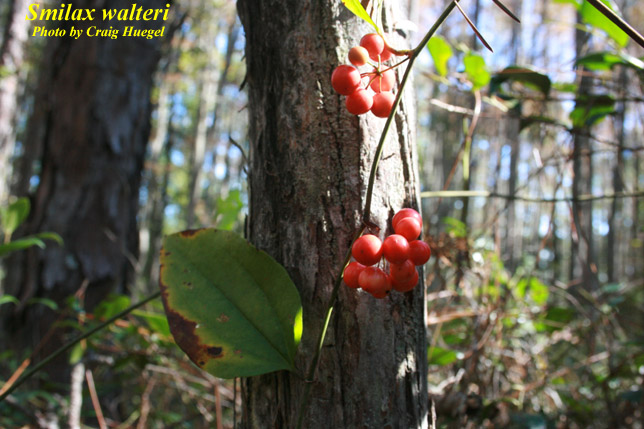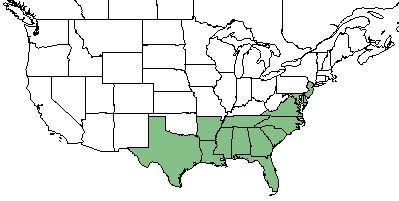Difference between revisions of "Smilax walteri"
| Line 30: | Line 30: | ||
==Ecology== | ==Ecology== | ||
===Habitat=== <!--Natural communities, human disturbed habitats, topography, hydrology, soils, light, fire regime requirements for removal of competition, etc.--> | ===Habitat=== <!--Natural communities, human disturbed habitats, topography, hydrology, soils, light, fire regime requirements for removal of competition, etc.--> | ||
| − | < | + | ''S. walteri'' is found in swamp forests, bogs, and other areas that are often submerged for a portion of the year.<ref name="Weakley 2015"/> |
| + | |||
| + | ===Phenology=== <!--Timing off flowering, fruiting, seed dispersal, and environmental triggers. Cite PanFlora website if appropriate: http://www.gilnelson.com/PanFlora/ --> | ||
| + | Flowering occurs from April through May and fruiting occurs from September through November but can persist beyond.<ref name="Weakley 2015"/> | ||
<!--===Seed dispersal===--> | <!--===Seed dispersal===--> | ||
<!--===Seed bank and germination===--> | <!--===Seed bank and germination===--> | ||
Revision as of 19:26, 19 January 2018
| Smilax walteri | |
|---|---|

| |
| Photo by Craig Huegel hosted at Atlas of Florida Plants | |
| Scientific classification | |
| Kingdom: | Plantae |
| Division: | Magnoliophyta - Flowering plants |
| Class: | Liliopsida - Moncots |
| Order: | Lilales |
| Family: | Smilacaceae |
| Genus: | Smilax |
| Species: | S. walteri |
| Binomial name | |
| Smilax walteri Pursh | |

| |
| Natural range of Smilax walteri from USDA NRCS [1]. | |
Common Name(s): coral greenbriar;[1][2] red-berried swamp smilax[1]
Contents
Taxonomic Notes
Synonym(s): S. megacarpa[2]
Description
Smilax walteri is a monoecious perennial shrub or vine.[2]
Distribution
This species is found on the coastal plain from the eastern edge of Texas, eastward to central peninsular Florida, north to New Jersey and inland to Tennessee.[1][2]
Ecology
Habitat
S. walteri is found in swamp forests, bogs, and other areas that are often submerged for a portion of the year.[1]
Phenology
Flowering occurs from April through May and fruiting occurs from September through November but can persist beyond.[1]